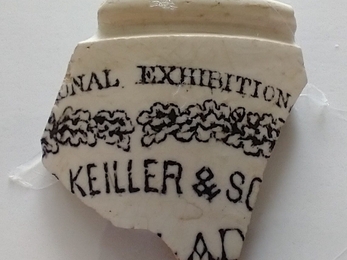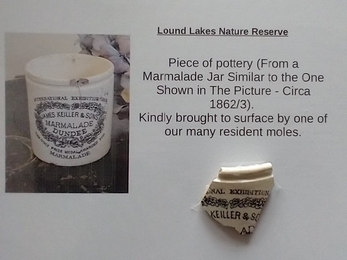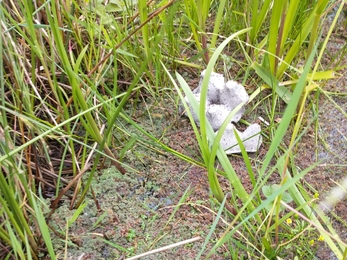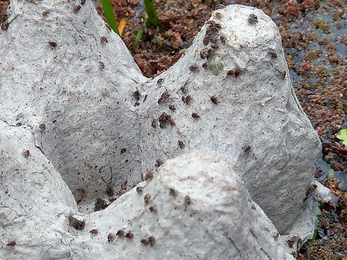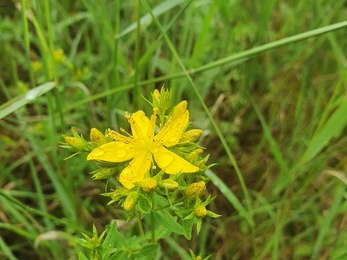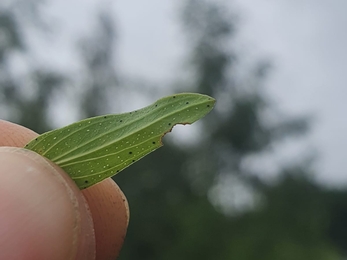Weekly wild news from our reserves - 9 July 2021
Silver washed fritillary at Bradfield Woods - Alex Lack
The team at Foxburrow Farm have been enjoying watching the spotted flycatchers feed their chicks which were nesting in the bird box. The chicks successfully fledged this week.
Mole unearths ancient pottery
Every curious archaeologists can't help but check out molehills for potential glimpses of the past. This fragment of a marmalade jar was unearthed by a mole at Lound Lakes this week. It is likely to originate from the 1800’s like the complete jar shown.
Carlton Marshes flora
As well as being amazing for bird watching, Carlton Marshes is also fantastically floristically diverse. Plants in flower on the reserve include bladderwort, a carnivorous plant which is currently flowering in the dykes as a result of stabilising the water levels, thanks to funding from the National Lottery Heritage Fund. Also in flower this week are common valerian, flowering rush and grass vetchling.
Damaging Azolla water fern treated with weevils at Castle Marshes
This week the north Suffolk reserve team released more azolla weevils at Castle Marshes. Castle Marshes had an infestation of the non-native water fern Azolla filiculoides, which spreads quickly forming thick mats across dykes and ponds. Azolla fern negatively affects the wetland by blocking out light and increasing nutrients, which in turn impacts upon rare aquatic plants, snails and fen raft spiders on the reserve. The azolla weevils will set to work eating the azolla fern, eventually leaving a healthy dyke with green duck weed instead. The weevils usually die out naturally once they have consumed all the water fern, so eradicate the fern without the need for dredging or chemical treatment.
Arger Fen wildflowers
Arger Fen's mixture of ancient woodland, naturally regenerating woodland pasture, wet meadows and furzy heath make for an equally impressive display of flowering plants.
Silver washed fritillary
Alex Lack, Bradfield Woods Warden, spotted his first silver-washed fritillary of the year this week. The swooping flight of this large and graceful butterfly is one of the most beautiful sights to be found in woodland during high summer. A large, fast-flying butterfly, it can be separated from other fritillaries by its pointed wings and silver streaks on the undersides which can be viewed as it stops to feed on flowers such as bramble. Although the butterfly is seen mostly in sunny glades and rides, it actually breeds in the shadier parts of adjacent woodland. The main foodplant of the caterpillar is common dog-violet.
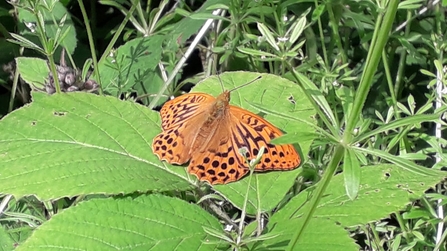
Silver washed fritillary at Bradfield Woods - Alex Lack
Slow worm
The slow worm is neither a worm nor a snake, but is, in fact, a legless lizard - its identity is given away by its abilities to shed its tail and blink with its eyelids.
Slow worms can be found in heathland, tussocky grassland, woodland edges and rides where they can find invertebrates to eat and a sunny patch in which to sunbathe. They are often found in mature gardens and allotments, where they like hunting around the compost heap. However, if you have a cat, you are unlikely to find them in your garden as cats predate them. Like other reptiles, slow worms hibernate, usually from October to March. Look out for this beautifully camouflaged individual captured on film at Lackford Lakes this week.
Sweet honeysuckle
Snape Marshes is looking and smelling wonderful this week with lots of flowering honeysuckle. Honeysuckle is a climbing plant, common in hedgerows, scrub and woodlands, where it twines itself around other shrubs and trees. The sweet, heady scent of honeysuckle, carried on a warm summer breeze, is one of the most delightful experiences of the season. Strongest at night, in order to attract pollinating moths, this scent is a happy addition to any garden. Whorls of trumpet- shaped flowers appear from June to August and clusters of red berries ripen in the autumn.
Honeysuckle is a true wildlife 'hotel': its nectar-rich, scented flowers attract moths like the impressive elephant hawk-moth which are, in turn, preyed upon by bats; new shoots attract blackfly which bring hungry blue tits, lacewings and ladybirds; its climbing stems provide nest sites and material for birds, such as blackbirds and pied flycatchers, and small mammals like dormice; and its juicy red berries are eaten by everyone from song thrushes to squirrels.
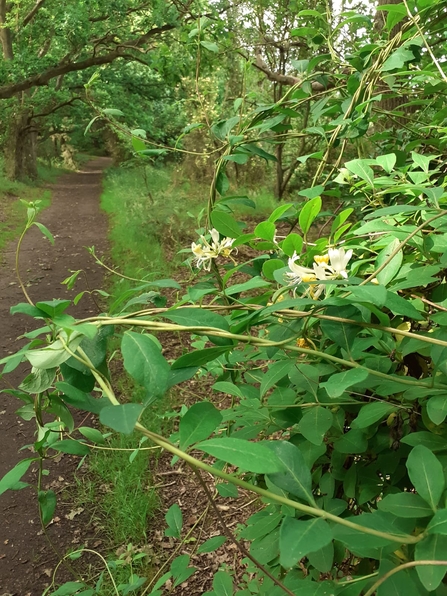
Honeysuckle at Snape Marshes - Charlie McMurray
Perforate St John’s Wort
Perforate St John's-wort can be found in open woods, along hedgerows and roadside verges, and on waste ground. Its bright yellow flowers appear from June to September and the blood-red juice that exudes from its stems has made it a focus for much myth and ritual. For instance, torchlight processions and gorse-burning were just some of the activities undertaken on Midsummer's Day, a pagan festival soon replaced by the Feast of St John the Baptist, hence the common name of this plant. It's also said that the red juice from its stem represents his bloody murder. Perforate St John's-wort can easily be identified as it appears to have many tiny 'holes' in its leaves; these are actually colourless glands that give off a 'foxy' smell. It has bright yellow, star-shaped flowers that are peppered with tiny black dots.


